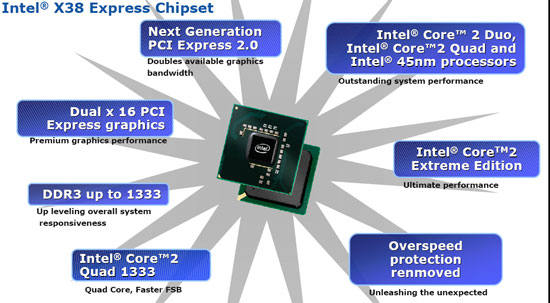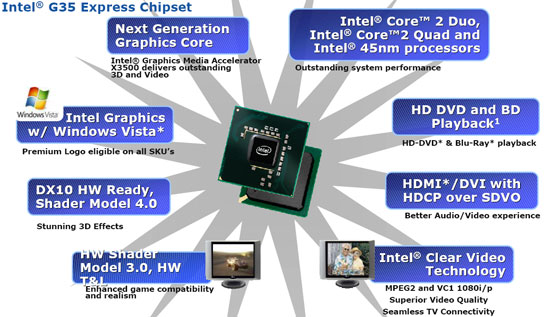Intel P35: Intel's Mainstream Chipset Grows Up
by Gary Key & Wesley Fink on May 21, 2007 3:45 PM EST- Posted in
- CPUs
X38 and G35 Chipsets - 3rd Quarter
While the X38 replacement for the 975X chipset will not launch until the 3rd quarter, Intel did provide enough information to make us wish it were here today. In addition to the feature enhancements on today's P35 chipset, X38 will add several unique features.
X38 will be the only Intel 3 series chipset to fully support dual x16 PCIe graphics. It was interesting that Intel did not specify CrossFire graphics in their literature, but we don't want to read too much into what wasn't said. The X38 will also be the first chipset to support PCI Express 2.0, which will replace the current PCIe standard. The other intriguing feature is something Intel calls "removing overspeed protection". This apparently refers to the fact X38 that will not have artificial bus speed limits on the chipset. We have seen what appeared to be artificial speed limits on Intel chipsets in the past, and an Intel chipset that can be pushed without artificial speed limits will be welcomed by all computer enthusiasts.
Other X38 features appear to be common to the P35 chipset, including full support for the 1333 processor bus and 1333 memory. X38 will also support all existing Intel processors and upcoming Penryn 45nm processors, just like other Intel Series 3 chipsets. X38 may also support other processor offerings, but Intel is not saying anything about that at this point.
G35
The third quarter will also see the introduction of Intel's G35 chipset, which will be Intel's most advanced integrated graphics chipset to date. While this may not be of huge interest to our readers, please keep in mind that the vast majority of computers sold today include integrated graphics. The G35 will be a very big deal for Intel and will be closely scrutinized by large-volume OEMs.

The G35 will be based on Intel's next-generation X3500 Graphics Media Accelerator. Full DX10 support is claimed, including support for Shader Model 4.0. For backwards compatibility X3500 also will support Shader Model 3.0 and Hardware Transform and Lighting (T&L). High Resolution DVD playback is also featured, with support for both HD-DVD and Blu-Ray playback. X3500 also is said to support HDMI and DVI. MPEG2 and VC1 1080i/p are also supported by the Intel Clear Video feature of X3500. Like the other series 3 chipsets, all current Intel processors are reported as well as future Penryn 45nm processors.
With DX10 support, all of the basic features are set in stone by Microsoft. That means that X3500 could actually be a true competitor on entry level configurations. Compared to previous Intel IGPs, X3500 certainly looks to bring some nice improvements to the platform, but we'll have to test actual performance and drivers before we can say for sure whether that's the case.










58 Comments
View All Comments
Gary Key - Tuesday, May 22, 2007 - link
X38 is basically ready, going through some fine tuning now... I understand it will be held until after the 1333CPUs are launched and DDR3 availability is a little more widespread/cost effective. I expect late August right now, but you never know with Intel. ;-)JarredWalton - Monday, May 21, 2007 - link
Technically Q3 is any time between July 1 and September 30, but if they're saying Q3 right now it probably means some time in August at best.gigahertz20 - Monday, May 21, 2007 - link
I applaud ASUS for only including 1 legacy connection on their P5K series, and not 4 like Gigabyte has chosen to do for their P35 board. Death to legacy connections!I mean really, why even include those damn legacy ports. The enthusiast that buys one of these boards will not be using them, they are a waste of space. Instead of having them, they should replace them with more USB ports or something useful.
JarredWalton - Monday, May 21, 2007 - link
I still have a parallel based laser printer that works fine for what I need, and I'm quite happy using it until it dies. There are also people that use serial devices that cost a lot of money. I don't think every board needs legacy support, but it's good that there are still options for people that *need* certain legacy devices. I've got several KVM switches that won't be useful if PS/2 ports disappear. :(yacoub - Monday, May 21, 2007 - link
Don't they offer USB or eSATA to serial/parallel convertors for those sort of situations? :)JarredWalton - Monday, May 21, 2007 - link
Sure, but I haven't had the need to try one yet. :)Truth be told, my printer has a USB port, but it behaves very poorly using a USB connection. It's a Brother HL-1240, and if the printer isn't powered on when you boot, Windows won't see it unless you unplug it and plug it back into a different USB port. It just works better with LPT, and as I said for my needs it's sufficient. The way I figure it, having the ports there isn't hurting most people. I've never seen anything to indicate they hamper performance, and how many extra transistors are "wasted" on these ports? Maybe a few thousand? Heheh. 45M transistors on the P35 is a bit crazy....
For what it's worth, between mouse, keyboard, and my LCD (which actually has four USB ports and flash memory readers), I haven't had any need for more than four USB ports on a motherboard. But then, I've got too many PCs around anyway.
TA152H - Monday, May 21, 2007 - link
I agree with you, but for another reason.I don't like USB at all, because a few years ago I ran some tests, on motherboards ranging from MVP3 based to a KT880, and USB seems to have a negative impact on performance, particularly on memory, in many cases.
It doesn't make my keyboard work any better, or my mouse, and I'm not sure why I need it for those functions at all. PS/2 ports don't do it well enough? I'm not crazy about this one size fits all approach, especially when it comes with overhead. The current ports work fine.
USB is a crappy, bloated technology. I'm not sure the "S" should stand for "serial" at all, I think there is a better word that begins with S for it.
strikeback03 - Tuesday, May 22, 2007 - link
Wake me up when Bluetooth works over PS/2.Though one reason to still include PS/2 keyboard/mouse is that it is hard to screw up support for those in Linux kernels. Same can't be said about USB.
TA152H - Tuesday, May 22, 2007 - link
Wake me up when I need Bluetooth.You could implement Bluetooth easily if USB didn't exist, but you're missing the point anyway. When you have to use USB for stuff that is handled more efficiently by PS/2 ports, it's a bad thing. Or other ports. It adds no function for these devices, and comes with overhead. It's a bad idea, but of course Intel was in the mode of making as many things as possible use CPU power so they could keep selling their latest and greatest.
It's just a rehash of some dorky Apple stuff that most people here don't remember. The original MacIntoy didn't have any slots, and you'd attach stuff to some serial bus for expansion. Naturally, it didn't work out, and they had to add slots. At least they didn't get rid of slots for USB, they just made it bloated.
DigitalFreak - Monday, May 21, 2007 - link
Man, if the P35 boards are going to be around the $250 mark, I'm not looking forward to see the price on the X38 boards.... :-(